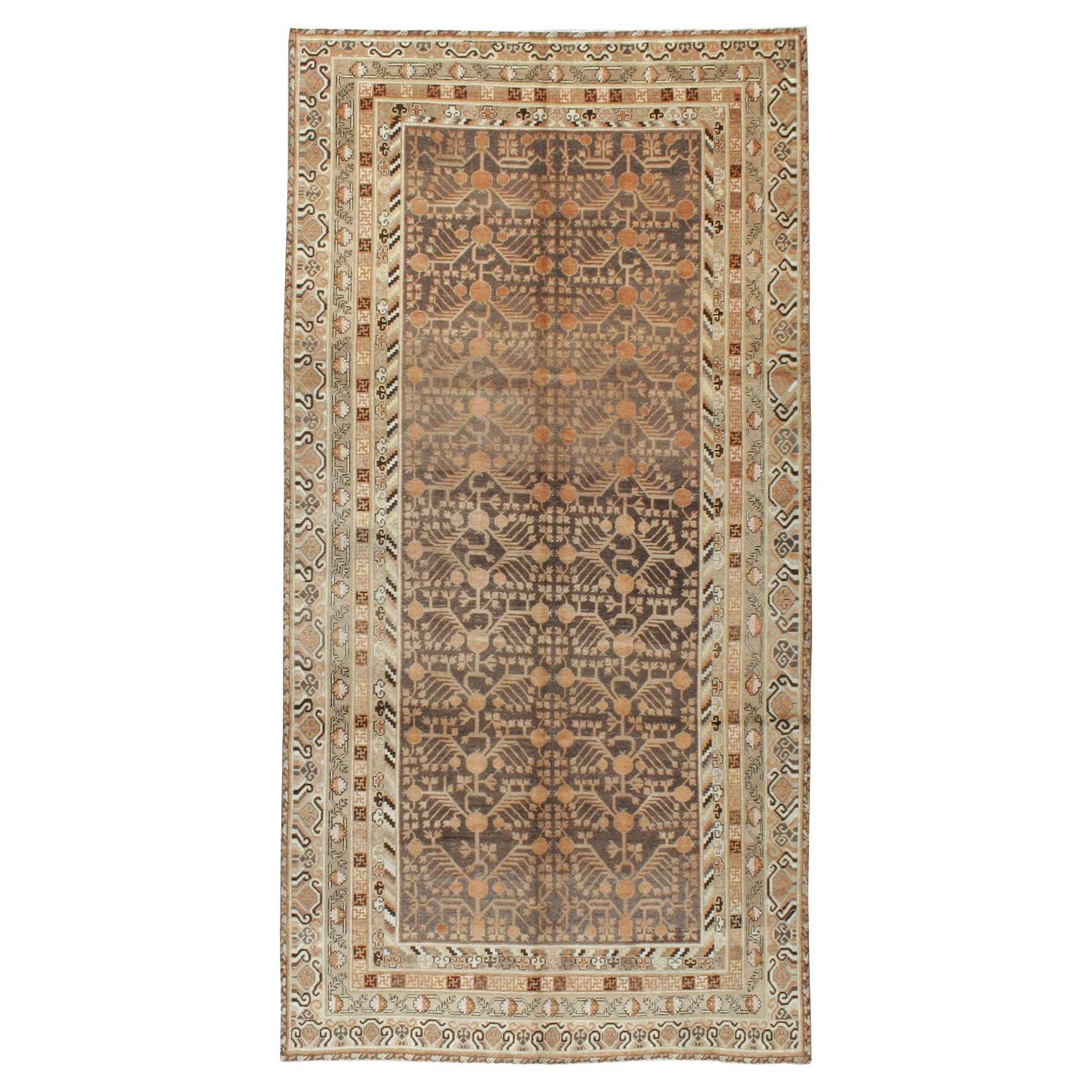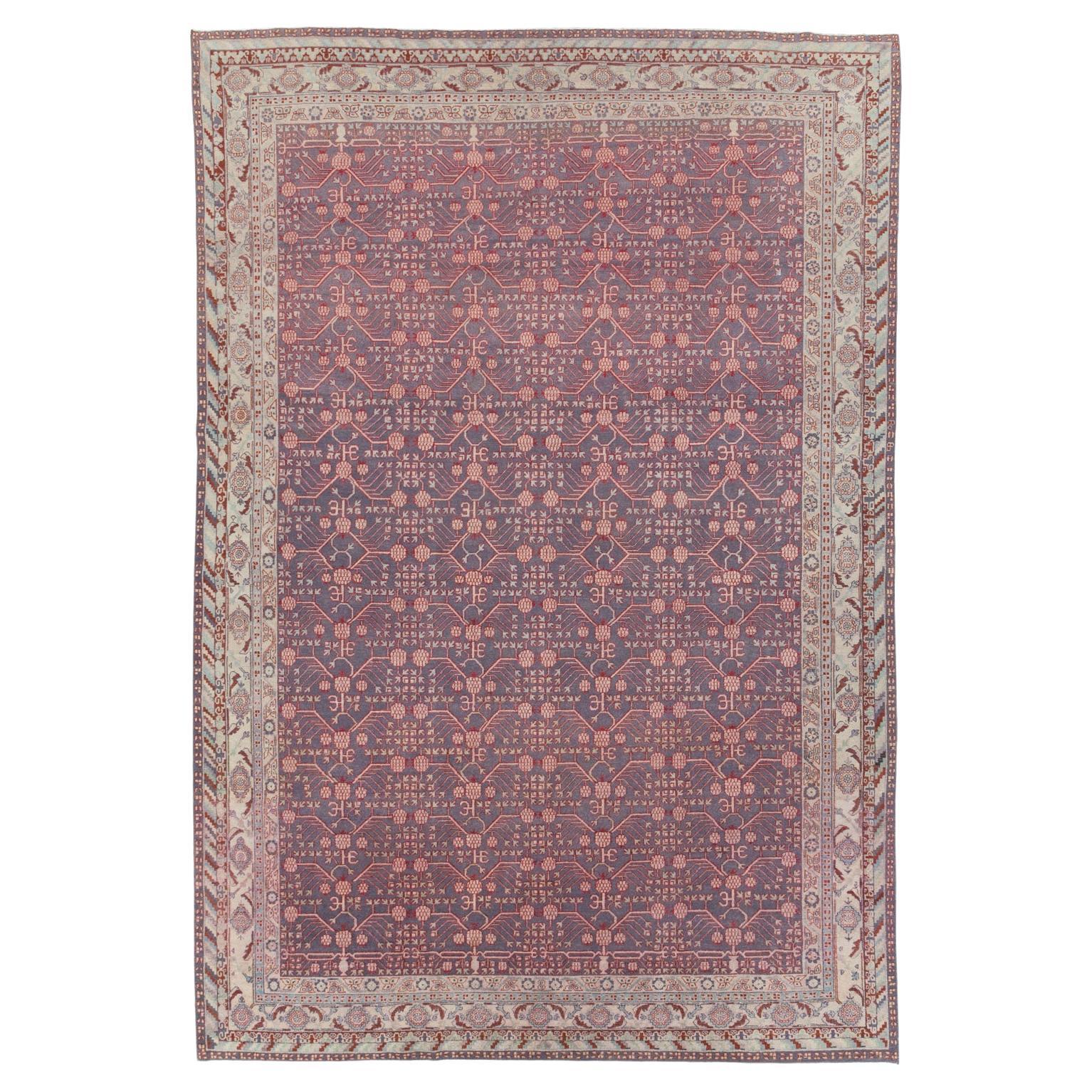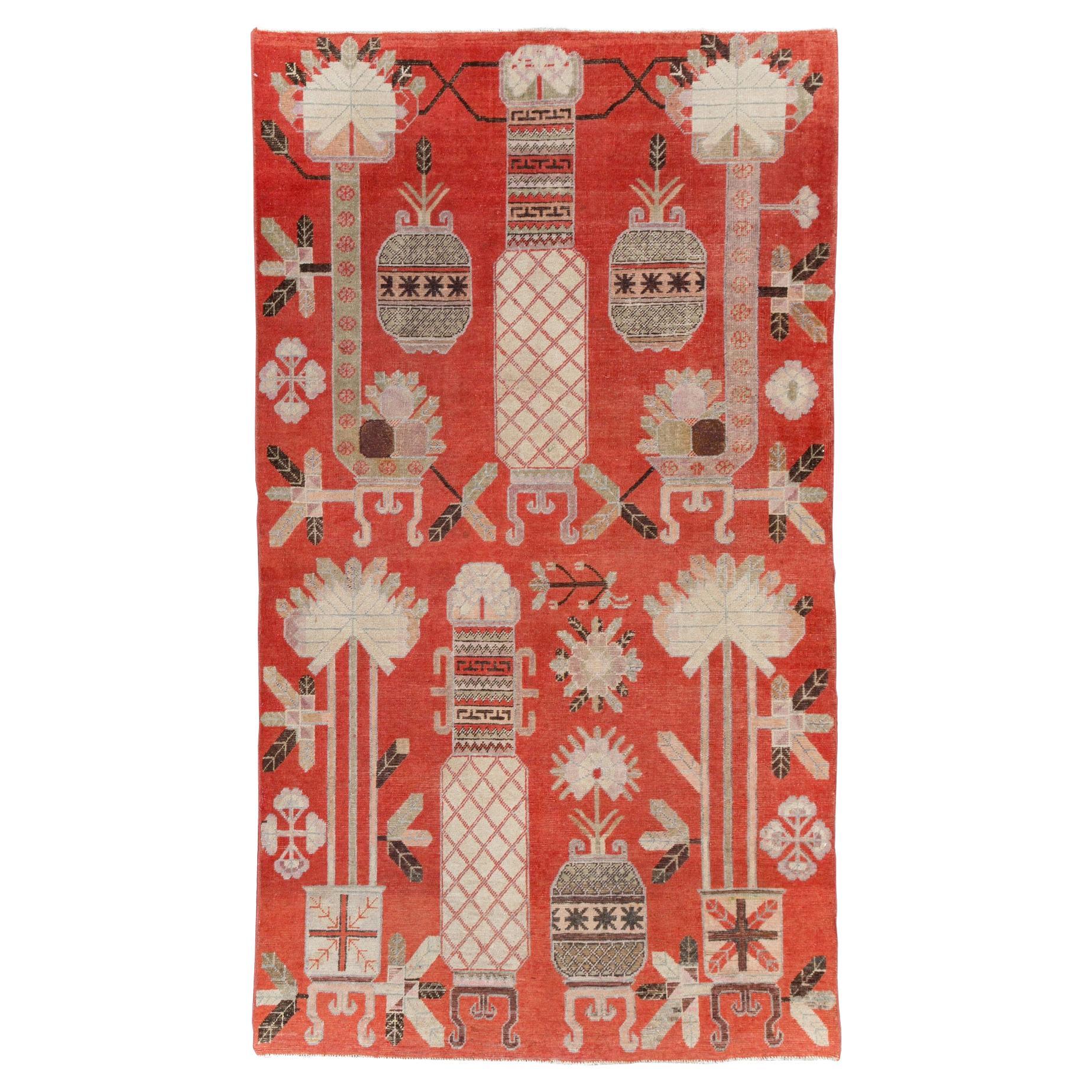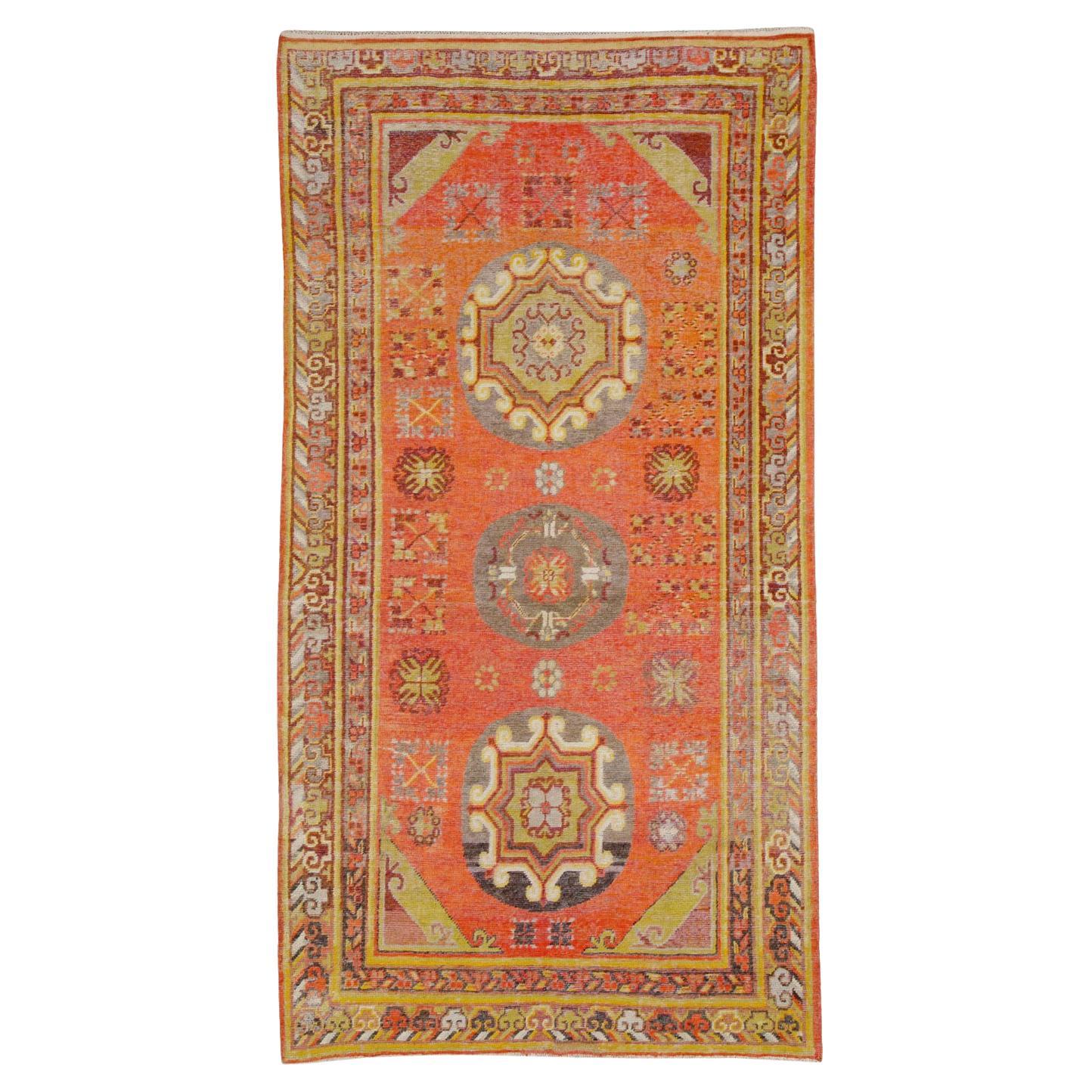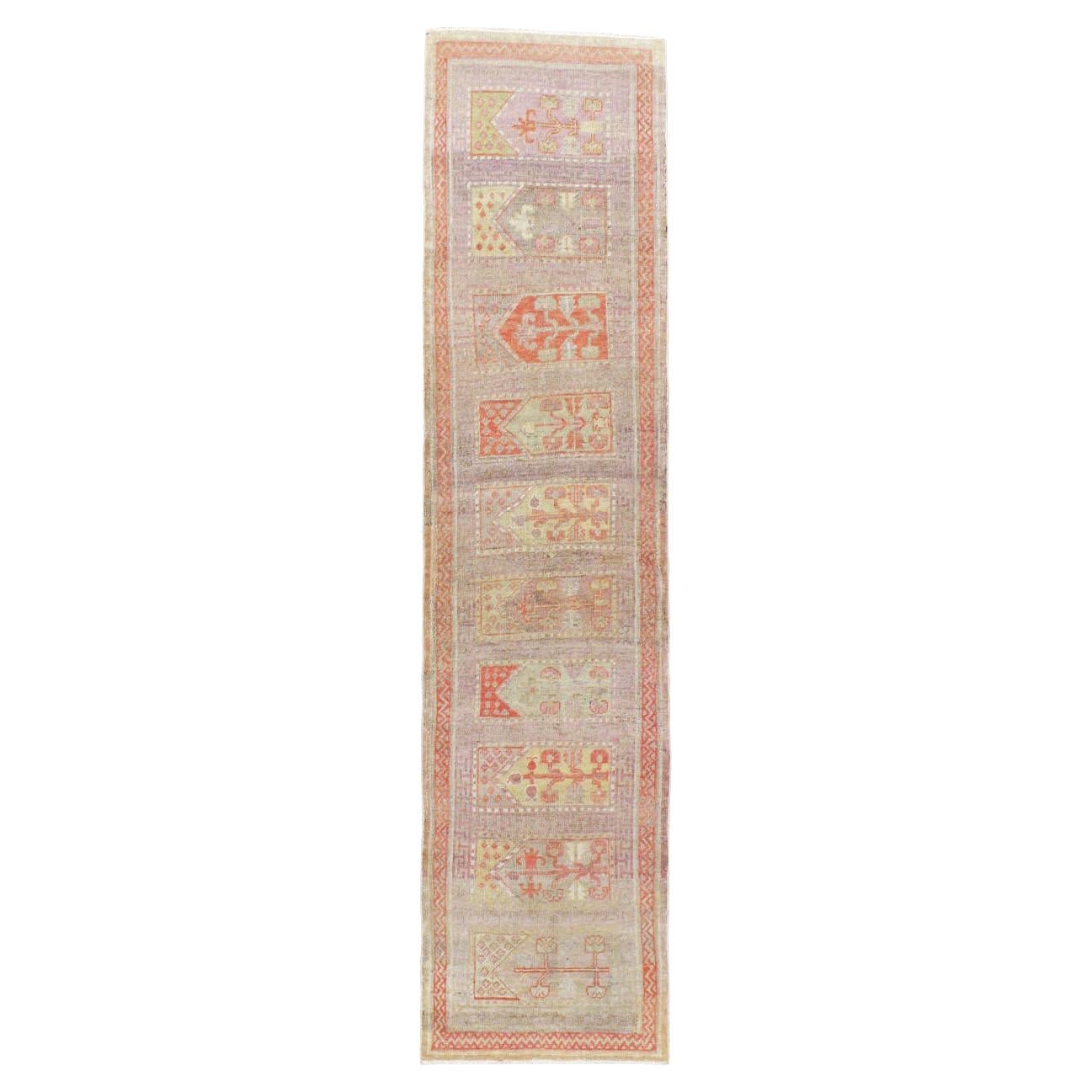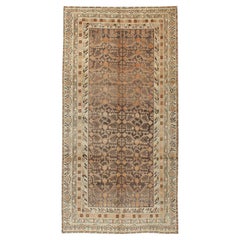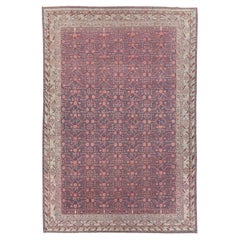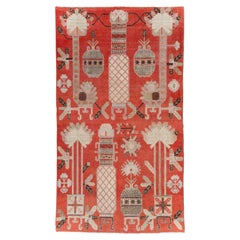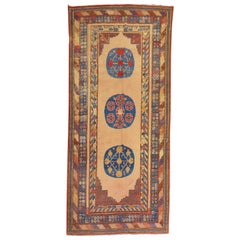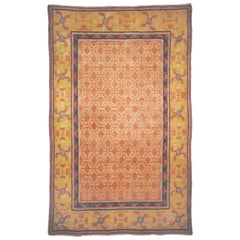Items Similar to Mid-20th Century Handmade East Turkestan Khotan Gallery Carpet
Want more images or videos?
Request additional images or videos from the seller
1 of 11
Mid-20th Century Handmade East Turkestan Khotan Gallery Carpet
About the Item
A vintage East Turkestan Khotan gallery carpet handmade during the mid-20th century.
Measures: 6' 8" x 12' 6".
- Dimensions:Width: 80 in (203.2 cm)Length: 150 in (381 cm)
- Style:Rustic (In the Style Of)
- Materials and Techniques:Wool,Hand-Knotted
- Place of Origin:
- Period:
- Date of Manufacture:Mid-20th Century
- Condition:Additions or alterations made to the original: This carpet has been professionally antique washed to soften its tonality. Wear consistent with age and use.
- Seller Location:New York, NY
- Reference Number:Seller: 184401stDibs: LU882328747422
About the Seller
5.0
Platinum Seller
Premium sellers with a 4.7+ rating and 24-hour response times
Established in 1989
1stDibs seller since 2009
586 sales on 1stDibs
Typical response time: <1 hour
- ShippingRetrieving quote...Shipping from: New York, NY
- Return Policy
Authenticity Guarantee
In the unlikely event there’s an issue with an item’s authenticity, contact us within 1 year for a full refund. DetailsMoney-Back Guarantee
If your item is not as described, is damaged in transit, or does not arrive, contact us within 7 days for a full refund. Details24-Hour Cancellation
You have a 24-hour grace period in which to reconsider your purchase, with no questions asked.Vetted Professional Sellers
Our world-class sellers must adhere to strict standards for service and quality, maintaining the integrity of our listings.Price-Match Guarantee
If you find that a seller listed the same item for a lower price elsewhere, we’ll match it.Trusted Global Delivery
Our best-in-class carrier network provides specialized shipping options worldwide, including custom delivery.More From This Seller
View AllEarly 20th Century Handmade East Turkestan Khotan Gallery Carpet
Located in New York, NY
An antique East Turkestan Khotan gallery carpet handmade during the early 20th century.
Measures: 6' 8" x 13' 1".
Category
Early 20th Century East Turkestani Rustic Chinese and East Asian Rugs
Materials
Wool
Early 20th Century Handmade East Turkestan Khotan Room Size Carpet
Located in New York, NY
An antique East Turkestan Khotan room size carpet handmade during the early 20th century.
Measures: 9' 6" x 14' 2".
Category
Early 20th Century East Turkestani Rustic Chinese and East Asian Rugs
Materials
Wool
Early 20th Century Handmade East Turkestan Khotan Rug
Located in New York, NY
An antique East Turkestan pictorial vase Khotan rug handmade during the early 20th century.
Measures: 4' 9" x 8' 7".
Category
Early 20th Century East Turkestani Rustic Chinese and East Asian Rugs
Materials
Wool
Early 20th Century Handmade East Turkestan Khotan Accent Rug
Located in New York, NY
An antique East Turkestan Khotan accent rug handmade during the early 20th century.
Measures: 4' 9" x 8' 11"
Category
Early 20th Century East Turkestani Rustic Central Asian Rugs
Materials
Wool
Early 20th Century Handmade East Turkestan Pomegranate Khotan Runner
Located in New York, NY
An antique East Turkestan Khotan rug in runner format with a pomegranate design handmade during the mid-20th century.
Measures: 2' 2" x 7' 6"
Central Asian Rugs & Carpets:
Central Asia is a vast area stretching from Northeastern Persia to western China, and from northern Afghanistan to the southern edge of Russia. The carpets can be usefully divided into three groups: the nomadic Turkmen rugs of Turkmenistan, northern Afghanistan, and northeastern Persia; the non-Turkmen tribal pieces from Kazakhstan, Uzbekistan, and Kirghizstan; and the urban creations of Khotan, Yarkand, and Kashgar, oasis cities of Western China (Xinjiang Province).
Commercially, the most important group is from Khotan, the easternmost of the Chinese Turkestan cities. The craft of rug weaving is primarily in the hands of Muslim Uighurs. Khotan carpets mix purely Central Asian design themes with Chinese elements. Native Khotan devices include pomegranate trees, upright flowers, round medallions, and yellow or red grounds. Chinese motives include triangular fretwork corners, swastika fretwork, and Yun-Tsao Tou (clouds and rain) diagonally striped polychrome borders. Cotton foundations, asymmetrical (Persian) knots, and medium weaves are standard. Some vintage Khotan are in horizontal, pictorial layouts with multiple various vases and plants. Saphs (multiple prayer niche panel carpets) are also a Khotan specialty. Others employ stepped and layered lozenge medallions, singly or in pairs. Still others, almost all antique, feature a stylized version of the allover Persian Herati design. Many of the oldest pieces employ brown wool wefts. Antique and vintage Khotans are almost always in the k’ang (double square) layout, conforming to the local household plans. Only relatively recently has the 6’ by 12’ or 7’ by 16’ format been replaced by the 9’ by 12’ size. As a result, an antique room size Khotan carpet is very uncommon. Reds are cinnamon, tomato and rust, never wine reds, crimson, or scarlet. Yarkand, farther west on the old Silk Road specializes in multi-medallion long carpets while Kashgar, farthest west and most under Persian influence, has traditionally knotted allover pattern pieces with finer weaves, often with silk piles, and enriched with medal thread, on cotton foundations. Extant Kashgars go back to the 17th century, but the carpet craft in Chinese Turkestan must be much older as fragments have been recovered from local tombs of the early C.E. period. Kashgars are the rarest of all East Turkestan rugs. Most available vintage East Turkestan carpets are interwar Khotans, many with pleasingly soft decorative palettes.
The non-Turkmen nomads include the Kazakh, Kirghiz, Uzbek, and Karakalpak groups. Like the Turkmen, they were once all seasonally migratory, dwelling in round felt tents (yurts), but have been settled, at least partially, in the villages, and have taken up crafts and agriculture instead of sheep herding. As a result, carpet production has transitioned from domestic tent use to commercial sale, but the roots of long traditions are still evident. The Uzbeks weave...
Category
Early 20th Century East Turkestani Modern Central Asian Rugs
Materials
Wool
Early 20th Century Handmade East Turkestan Saph Khotan Runner
Located in New York, NY
An antique East Turkestan Saph Khotan rug in runner format handmade during the early 20th century.
Measures: 2' 2" x 9' 3"
Central Asian Rugs & Carpets:
Central Asia is a vast area stretching from Northeastern Persia to western China, and from northern Afghanistan to the southern edge of Russia. The carpets can be usefully divided into three groups: the nomadic Turkmen rugs of Turkmenistan, northern Afghanistan, and northeastern Persia; the non-Turkmen tribal pieces from Kazakhstan, Uzbekistan, and Kirghizstan; and the urban creations of Khotan, Yarkand, and Kashgar, oasis cities of Western China (Xinjiang Province).
Commercially, the most important group is from Khotan, the easternmost of the Chinese Turkestan cities. The craft of rug weaving is primarily in the hands of Muslim Uighurs. Khotan carpets mix purely Central Asian design themes with Chinese elements. Native Khotan devices include pomegranate trees, upright flowers, round medallions, and yellow or red grounds. Chinese motives include triangular fretwork corners, swastika fretwork, and Yun-Tsao Tou (clouds and rain) diagonally striped polychrome borders. Cotton foundations, asymmetrical (Persian) knots, and medium weaves are standard. Some vintage Khotan are in horizontal, pictorial layouts with multiple various vases and plants. Saphs (multiple prayer niche panel carpets) are also a Khotan specialty. Others employ stepped and layered lozenge medallions, singly or in pairs. Still others, almost all antique, feature a stylized version of the allover Persian Herati design. Many of the oldest pieces employ brown wool wefts. Antique and vintage Khotans are almost always in the k’ang (double square) layout, conforming to the local household plans. Only relatively recently has the 6’ by 12’ or 7’ by 16’ format been replaced by the 9’ by 12’ size. As a result, an antique room size Khotan carpet is very uncommon. Reds are cinnamon, tomato and rust, never wine reds, crimson, or scarlet. Yarkand, farther west on the old Silk Road specializes in multi-medallion long carpets while Kashgar, farthest west and most under Persian influence, has traditionally knotted allover pattern pieces with finer weaves, often with silk piles, and enriched with medal thread, on cotton foundations. Extant Kashgars go back to the 17th century, but the carpet craft in Chinese Turkestan must be much older as fragments have been recovered from local tombs of the early C.E. period. Kashgars are the rarest of all East Turkestan rugs. Most available vintage East Turkestan carpets are interwar Khotans, many with pleasingly soft decorative palettes.
The non-Turkmen nomads include the Kazakh, Kirghiz, Uzbek, and Karakalpak groups. Like the Turkmen, they were once all seasonally migratory, dwelling in round felt tents (yurts), but have been settled, at least partially, in the villages, and have taken up crafts and agriculture instead of sheep herding. As a result, carpet production has transitioned from domestic tent use to commercial sale, but the roots of long traditions are still evident. The Uzbeks weave...
Category
Early 20th Century East Turkestani Folk Art Central Asian Rugs
Materials
Wool
You May Also Like
Exquisite 19th Century Antique East Turkestan Khotan Rug
Located in New York, NY
Early 20th century colorful antique Khotan gallery rug. The field is a bone color, denim blue, rust accents are dominant.
Measures: 5'8" x 12'11".
Category
Early 20th Century Turkmen Khotan Central Asian Rugs
Materials
Wool
Early 20th Century East Turkestan Khotan Rug
Located in New York, NY
East Turkestan, circa 1900
Measures: 6'1" x 3'10" (185 x 117 cm)
Handwoven.
Category
Early 20th Century East Turkestani Khotan Chinese and East Asian Rugs
Materials
Wool
Early 20th Century East Turkestan Khotan Rug
Located in New York, NY
East Turkestan ca. 1900
13'4" x 7'0" (406 x 213 cm)
Handwoven
Category
Early 20th Century East Turkestani Tibetan Chinese and East Asian Rugs
Materials
Wool
Early 20th Century East Turkestan Khotan Rug
Located in New York, NY
East Turkestan ca. 1900
9'1" x 4'6" (277 x 137 cm)
handwoven
Category
Early 20th Century East Turkestani Khotan Chinese and East Asian Rugs
Materials
Wool
Zabihi Collection Ivory Early 20th Century Khotan Gallery Size Rug
Located in New York, NY
Authentic early 20th century Khotan rug with repetitive pomegranate motif on an ivory ground. Dominant accents in apricot and brown, circa 1920
Measures: 5'9" x 11'6"
Khotan, a...
Category
Early 20th Century East Turkestani Chinese Chippendale Central Asian Rugs
Materials
Wool
Shabby Chic Gray Khotan Gallery Size Wool Late 19th Century Carpet
Located in New York, NY
Faded Distressed Khotan rug in a gallery format,
circa late 19th century, measures: 6'3" x 12'6"
Khotan rugs were produced in Eastern Turke...
Category
Antique Late 19th Century East Turkestani Rustic Central Asian Rugs
Materials
Wool
Recently Viewed
View AllMore Ways To Browse
Wood Side Pull Out One Table
1940 Armchair Leather Wood
1950s Cane Backed Armchair
1950s Canvas Lounge Chairs
1960s Leather Club Chair
1970s Swedish Leather Lounge Chair
19th Century Champagne Glasses
6 Fully Upholstered Dining Chairs
Ab Lounge Used
Antique Japanese Wall Panels
Antique Prints Of Dogs
Antique Roll Top Desk Furniture
Antique Roll Top Desks
Antique Silver Owl
Antique St Nicholas
Antique Swedish Chairs White
Arm Daybed
Art Deco Champagne Bucket
